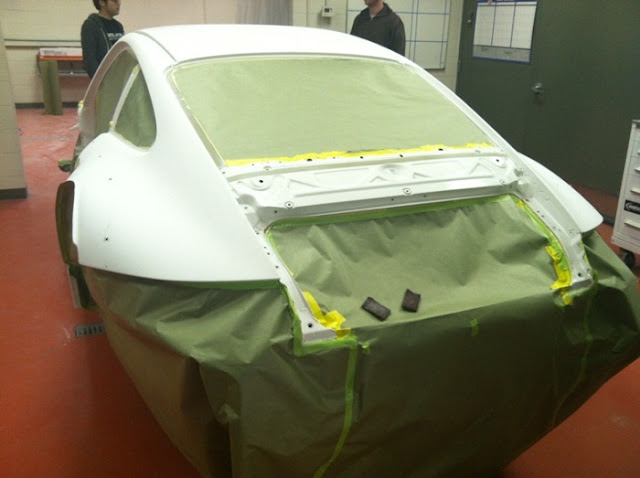Since Falken Tire started racing in the American Le Mans
Series in 2008, the team vehicles bore the Corporation’s unique livery. The teal
front end leads into a bold, blue rear, with Falken’s signature scallops on the
doors and roof of the car. This design is the official Falken Tire competition
livery that is recognized internationally.
In the American Le Mans Series field, no livery matches
the sleek, sexy design of the Falken Porsche. Here is a look at the intricate
process of creating the look of the No. 17 Falken Tire Porsche.

A new car arrives to a team in plain color, without team
liveries or sponsor logos. If you look closely, here, the 2012 Porsche still
has the shipping slip.

In order to paint the car in the iconic Falken livery,
every part of the car that will be painted first gets sanded down. Once the
factory gloss is gone, the new layer of paint will be smooth and stick to the
body of the car.

Body parts of the car are removed, and the teal layer is
the first color applied to the car. Once the teal dries, portions of the car
are covered again to protect from the next phase of blue paint. To create the
Falken Tire signature scallops on the door panels and the roof of the car, a
vinyl mask is used when spraying on the blue paint.
To keep the branding of the signature look consistent,
the Falken Tire Corporation provides the painter with specific guidelines of
the car’s design. When applying the vinyl mask to the car, the doors are put
back on the Porsche to ensure the design stays even across the roof and doors. After
the mask is applied, the pieces are then taken back off the car to be painted. Due
to the car’s low ride height (50mm), the rocker panels below the doors suffer
usual wear and tear, and need to be repainted often.



Once the colors are on the car, the painter applies a
clear coat to encapsulate the color and add shine. After an hour of drying, the
bodywork is complete.



If a piece of body work suffers contact, it gets
repaired, sanded down, and painted again with the color, followed by a clear
coat. Here you can see some pieces of the car after the sanding, prepped and
waiting for the colors.

Once the car is fully dry, all of the team and sponsor
logos are placed on the car according to the specifications of Falken Tire and the
International Motorsports Association.


Each crew member’s helmet is painted by the same process.
With the helmets, it is imperative that the vinyl mask shrunk down and that the
angles for the Falken scallops are kept the same. All of the helmets are
painted at the same time, following the same process.

Again, we asked our fans on twitter and the forums to
send in your questions about the painting process. Thanks to everyone who sent in questions!
Patrick
(@twincheckers98) and Marc (@forzasenna): What are the official names for the blue
and green?
The Blue is Lamborghini Blue Nova and the teal is PPG
Summer Green.
Ben
(@TheBenWedge): Everyone knows
racing stripes add 10hp and flames reduce weight by 4.1%. why no racing stripes
or flames?
The scallops are Falken Tire’s
version of racing stripes. They add our own advantage.
Matt (@mattastic247): How does one get a sweet gig painting race cars?
Start at the bottom, and keep working hard to get your way to the top. If you rest, they could find someone that’s more motivated than you. It’s a competitive type of job. You should go to a technical school, get trained, work in a body shop and production environment for a few years to develop your kills. Augment that with graphics work while you’re learning and at a point all that culminates where you’re fast and able to do graphics work.
I
Rosputnik and Erin (@lainey_vb131): How much freedom does the painter get when
designing a car livery in regards to how expressive can it be and how much
artistic license is allowed to be used when working with sponsor logos?
Very little. They all need to look a certain way. They
all have to work together. It’s an overall package. The paint job is dictated
by Falken for the sponsors and overall brand, and the other series decals and
logos are dictated by the series and IMSA.
@skinkyL0u:
What kind of paint? Like epoxy, or acrylic, etc.?
PPG based clear coat. Paint is Epoxy sealer, basecoat is
Urethane clear coat.
@skinkyL0u: you repaint, how do you prep the area? Is
there a clear coat?
First you remove old paint, sand out any defects, shoot
primer, block sand primer, clean then mask for paint.
Craig:
(@CraigMoretto): If there was a 2nd car, would the paint
scheme be the exact same, swapped or completely different.
The paint scheme would be identical but with a very small
difference that does not affect the scalloped livery, likely on the mirrors
and/or windshield, to tell the two cars apart while on track. The only
way this would change is if there was a sponsor that was funding the second car
and had their own marketing program to execute.
Coming
Up:
The season start is quickly approaching! Team Falken Tire
will be appearing at the ALMS Winter Test next month with the #17 Porsche in
preparation for the 12 Hours of Sebring! Keep up with all the news on twitter.com/FalkenALMS.